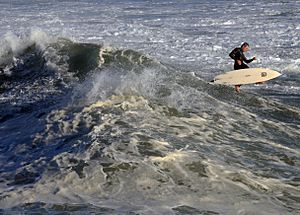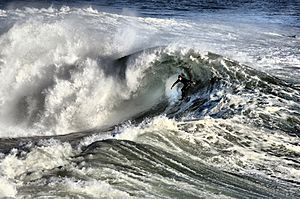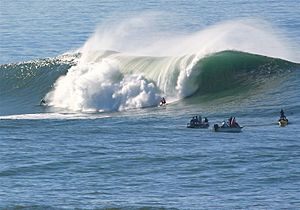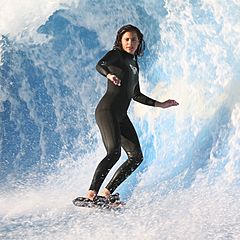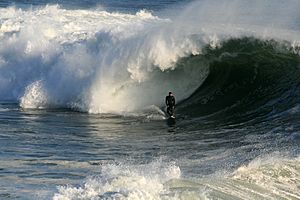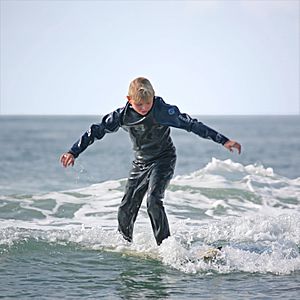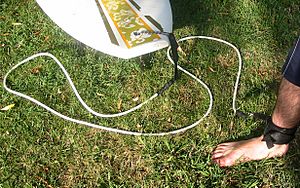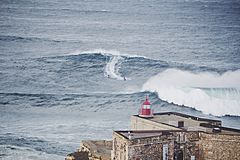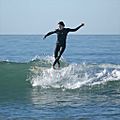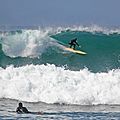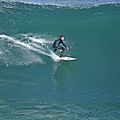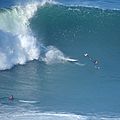Surfing facts for kids
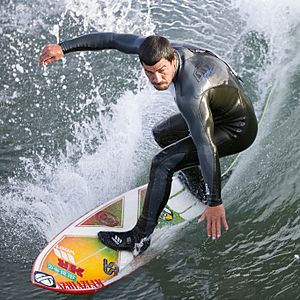
Dustin Ray surfing at the Cayucos Pier, Cayucos, California
|
|
| Highest governing body | World Surf League (WSL), International Surfing Association (ISA) |
|---|---|
| Characteristics | |
| Mixed-sex | Yes, separate competitions |
| Presence | |
| Country or region | Worldwide |
| Olympic | Will debut in 2020 |
- Surfing is also a verb meaning "To browse the World Wide Web"
Surfing is a cool water sport where you ride ocean waves on a surfboard. You try to catch a wave and glide all the way to the shore. It's super popular with people of all ages!
Surfing started with the Polynesian people over 4000 years ago. It's a sport that lets you enjoy nature and be free. While people surf in many Pacific countries, Hawaii is still a very important place for surfing. Many big international surfing contests happen there every year. Surfing is also a big deal in Australia, the US, and Northern Europe.
Contents
How Did Surfing Begin?
For hundreds of years, surfing was a huge part of ancient Polynesian culture. British explorers might have first seen surfing in Tahiti in 1767. Later, in 1779, Lieutenant James King wrote about surfing in Hawaii. He was finishing the journals of Captain James Cook.
When writer Mark Twain visited Hawaii in 1866, he saw people surfing. He wrote about "a large company of naked natives... amusing themselves with the national pastime of surf-bathing."
People also surfed on planks and canoes in Samoa and Tonga long before Hawaiians did.
In 1885, three Hawaiian princes visited Santa Cruz, California. They surfed the San Lorenzo River mouth on special redwood boards. This was an early example of surfing in California. In 1890, John Wrightson became the first British surfer. He learned from two Hawaiian students at his college.
George Freeth (1883–1919) is often called the "Father of Modern Surfing." Many believe he was the first modern surfer.
In 1907, Henry E. Huntington helped bring surfing to California. He saw Hawaiian boys surfing and wanted to attract visitors to Redondo Beach, California. He hired George Freeth to show off his surfing skills. Freeth made surfing easier by cutting long, heavy boards in half. This created the first "Long board." Another Hawaiian, Duke Kahanamoku, helped spread surfing to the U.S. and Australia. He was an Olympic gold medalist in swimming in 1912 and 1920.
In 1975, professional surfing tours began. That year, Margo Oberg became the first female professional surfer.
What Makes a Good Surf Wave?
Waves that are good for surfing are called "swell." Swell forms when wind blows steadily over a large area of open water. The stronger the wind and the longer it blows, the bigger the swell. That's why coastlines facing large oceans often have bigger waves.
Local wind conditions also affect how good a wave is. A light wind blowing from the land out to the ocean (called "offshore" wind) is best. It makes the wave smooth and can even create a "barrel" or "tube" where the wave curls over. Waves can be "left-handed" or "right-handed" depending on how they break.
Waves usually get their names from the type of ground they break over. For example, there are:
- Beach breaks: Waves break over sand.
- Reef breaks: Waves break over a coral or rock reef.
- Point breaks: Waves break around a rocky point of land.
The shape of the ocean floor under the wave is super important. It changes how the wave breaks. At beach breaks, the sand can shift, changing the waves from week to week. Today, we use computers to predict swells around the world, which helps surfers know where to go.
During winter, big swells often form in the middle parts of the ocean. These waves usually hit west coasts. East coasts get big winter swells when storms form closer to the tropics. In summer, tropical storms can also create large swells.
Some surf trips and camps take surfers to faraway, tropical places. There, steady "tradewinds" often create perfect offshore conditions. Swells usually arrive in "pulses," meaning they come in for a few days, then there's a break, and then another swell arrives.
You can find lots of free weather data online from places like NOAA. This helps create many surf forecasting websites.
How Strong Are Waves?
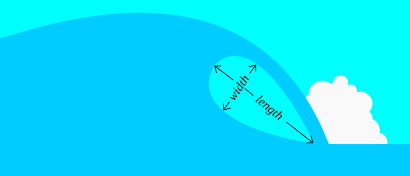
The shape of a "tube" or "barrel" wave is measured by how long it is compared to how wide it is.
- Square: Less than 1:1 (wider than long)
- Round: 1-2:1
- Almond: More than 2:1 (longer than wide)
The speed of a tube wave depends on its angle.
- Fast: 30 degrees
- Medium: 45 degrees
- Slow: 60 degrees
| Fast | Medium | Slow | |
|---|---|---|---|
| Square | The Cobra | Teahupoo | Shark Island |
| Round | Speedies, Gnaraloo | Banzai Pipeline | |
| Almond | Lagundri Bay, Superbank | Jeffreys Bay, Bells Beach | Angourie Point |
Can We Build Surf Waves?
Good surf brings in tourists, so people have built artificial reefs and sand bars. These artificial reefs are like underwater walls made of sandbags or concrete. They create waves for surfing and also protect the coast from erosion. Sometimes, even ships that get stuck on sandy bottoms can create good waves!
For example, the Chevron Reef was built in El Segundo, California. But it didn't make good waves, so it was removed. However, in Kovalam, India, an artificial reef worked well. It created a good wave, stopped soil erosion, and made a nice home for sea creatures.
Artificial Waves: Surfing Without the Ocean?
What if there are no waves at the beach? Wave pools try to solve this problem by creating perfect waves. But most wave pools are very expensive to build and run. Also, many wave pools make waves that are too small for good surfing.
The Seagaia Ocean Dome in Japan was a famous surfable wave pool. It could make waves up to 3 meters (10 feet) tall! It used special pumps to create different types of waves, like barrels. But it cost a lot to build and keep running, so it closed in 2007. In England, a new wave pool called "The Wave" is being built near Bristol. It will let people surf even if they can't get to the coast.
There are two main types of artificial waves:
- Stationary waves: These pump a layer of water over a smooth shape. The water rushes by, and the surfer stays in one spot. These are great for learning the basics of surfing.
- Wave pools: These try to create waves that move and break like real ocean waves. In 2018, the first professional surfing contest was held in a wave pool.
Cool Surfing Moves

Surfing starts when you paddle your board toward the shore. You try to match the speed of the wave. Once the wave pushes you forward, you stand up and ride! The main goal is to stay just ahead of the breaking part of the wave (the "whitewash"). A common challenge for new surfers is just catching the wave.
Surfers show their skills by controlling their board in tough conditions. They ride challenging waves and do cool moves like:
- Strong turns and cutbacks: Turning the board back towards the breaking wave.
- Carving: A series of strong, quick turns.
- Floater: Riding on top of the breaking curl of the wave.
- Off the lip: Turning sharply off the top of the breaking wave.
- Air: Launching off the wave into the air and landing back on the board.
The tube ride is considered the best move in surfing. When a wave breaks perfectly, it forms a hollow tunnel. An experienced surfer can position themselves inside this tunnel. From the shore, the surfer might disappear inside the wave! The longer you stay in the tube, the better the ride. This is also called "getting tubed," "barreled," "shacked," or "pitted." Some famous tube-riding spots are Pipeline in Hawaii and Teahupoo in Tahiti.
Moves usually done on longboards include:
- Hanging ten: Having both feet on the very front of the board with all ten toes hanging off the edge.
- Hanging five: Having just one foot near the front with five toes off the edge.
Other cool moves:
- Cutback: Gaining speed down the wave, then turning back to change direction.
- Floater: Riding on top of the wave's breaking curl. Great for small waves.
- Top-Turn: Turning off the very top of the wave. Can be used for speed or to spray water.
- Airs/Aerials: These are becoming very popular. An air is when a surfer gets enough speed to launch off the wave and fly into the air. They then land back on the wave.
Airs can be:
- Straight airs: Little to no rotation.
- Rotational airs: Spinning 90 degrees or more.
- 180 degrees (air reverse): Spinning to land backward, then turning back.
- 360 degrees (full rotor): A full spin, landing where you started.
- 540 degrees: A full spin plus another 180 degrees. Very hard to land!
- Backflip: A flip backward.
- Rodeo flip: A backflip with a 180-degree spin.
Surfers often "grab" their board during airs to help them stay attached. Common grabs include:
- Indy: Grabbing the inside edge of the board with your back hand.
- Slob: Grabbing the inside edge of the board with your front hand.
- Lien: Grabbing the outside edge of the board with your front hand.
- Stalefish: Grabbing the outside edge of the board with your back hand.
- Double grab: Grabbing both the inside and outside edges of the board.
Surfing Words You Should Know
Surfing has its own special language! The Glossary of surfing lists many words used to describe different parts of the sport. Some of these words have even become common in everyday talk.
Learning to Surf
Many popular surf spots have surf schools and camps where you can learn. These camps often last several days and teach you the basics. They usually include lessons, meals, and surfboards.
Most lessons start with safety tips and instruction on land. Then, instructors help you catch waves on long, soft boards. These "softboards" are great for learning because they are safer, easier to paddle, and more stable. "Funboards" are also popular for beginners. They are a good mix of a longboard's stability and a shorter board's size. New surfers usually learn on softboards that are about 2.1 to 2.4 meters (7 to 8 feet) long. Because the boards are soft, there's less chance of getting hurt.
One-on-one lessons are best, but group lessons are also common. The best places to learn have small, gentle waves that break softly. A sandy ocean floor is also safer.
Surfing involves several skills:
- Paddling strength: You need strong arms to paddle out and catch waves.
- Positioning: Knowing where to be to catch the wave at the right time.
- Timing: Popping up quickly as the wave starts to push your board.
- Balance: Staying upright on the board. Practicing with a Balance board can help!
Paddling, popping up, and balancing take a lot of energy and core strength. A good warm-up can help prevent injuries.
What Gear Do Surfers Use?
You can surf on many different things, like surfboards, stand up paddle boards (SUPs), bodyboards, and more! Early surfboards were made of solid wood and were very big and heavy. Lighter balsa wood boards came later, making surfing easier and more fun.
Most modern surfboards are made of fiberglass foam with wooden strips inside. They are covered with fiberglass cloth and resin. Newer boards use stronger, lighter materials like epoxy resin and polystyrene foam. These boards float better and are faster. However, some experienced surfers prefer traditional boards because they feel more connected to the wave.
Other important gear includes:
- Leash: A cord that connects your ankle to your board. It stops your board from floating away or hitting others if you fall.
- Surf wax: Rubbed on the board to help your feet grip.
- Traction pads: Sticky pads on the board for extra grip.
- Fins (skegs): Attached to the bottom of the board to help you steer. They can be permanent or removable.
For clothing, in warm water, surfers wear swimsuits, boardshorts, or rash guards (shirts that protect from the sun and board rash). In cold water, surfers wear wetsuits, boots, hoods, and gloves to stay warm. Some rash vests even have titanium for extra warmth without being bulky. Big wave surfers are now using inflatable vests or colored dye packs for safety.
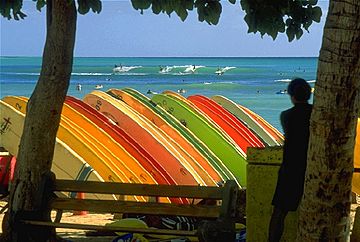
There are many different surfboard sizes and shapes:
- Modern longboards: Usually 2.7 to 3 meters (9 to 10 feet) long. They are like the first surfboards but with modern improvements. Longboarders do traditional "walking" moves and quick turns.
- Modern shortboards: Started in the late 1960s. Today's common "thruster" style has three fins and is usually 1.8 to 2.1 meters (6 to 7 feet) long.
- Midsize boards (funboards): Offer more maneuverability than a longboard and more float than a shortboard. Some surfers love them, while others think they are just "okay."
- Egg: A shortboard that paddles like a longboard.
- Fish: Shorter, flatter, and wider than a normal shortboard, often with a split tail. Great for smaller waves.
- Gun: A long, thick board with pointed ends. Designed specifically for surfing very big waves.
The Science of Surfing
Surfing involves the science of how waves form, how surfboards work, and how surfers interact with the water.
How Do Waves Form?
Ocean waves are like moving bumps of water. Wind pushes the water, creating ripples that grow into bigger, faster waves. The biggest waves form in strong storms that last a long time.
Waves created in the open ocean are called "deep-water waves." They don't touch the ocean floor. As these waves travel towards shore, they become "shallow-water waves." They start to interact with the bottom, which slows them down at the base. The top of the wave keeps moving fast, causing it to get taller and then "break" or fall over.
The "surf zone" is where all these waves come together. A good surfing wave moves at about 5 meters per second. Local winds can also affect how waves break.
- Onshore winds: (blowing from the ocean to land) can make waves choppy and break randomly. These are often better for experienced surfers.
- Light offshore winds: (blowing from land to ocean) create smoother waves.
- Strong offshore winds: Can create "plunging" or "barrel" waves, which are big and powerful.
What Makes a Wave Surfable?
Scientists look at a few things to decide if a wave is good for surfing:
- Breaking wave height: How tall the wave is when it breaks. Surfers often estimate waves to be taller than scientists measure them! Surfable waves can be from 1 to 20 meters (3 to 65 feet) high.
- Wave peel angle: This angle shows how fast the wave crest moves. A smaller angle means a faster wave.
- Wave breaking intensity: How much force the wave has when it breaks.
- Wave section length: The distance between two breaking parts of a wave.
These factors help match waves to a surfer's skill level.
| Skill level | Peel angle (degrees) | Wave height (meters) | Section speed (meters/second) | Section length (meters) | General locations of waves |
|---|---|---|---|---|---|
| Beginner | 60-70 | 2.5 | 10 | 25 | Low Gradient Breaks; Atlantic Beach, Florida |
| Intermediate | 55 | 2.5 | 20 | 40 | Bells Beach; New Zealand |
| Competent | 40-50 | 3 | 20 | 40-60 | Kirra Point; Burleigh Heads |
| Top Amateur | 30 | 3 | 20 | 60 | Bingin Beach; Padang Padang Beach |
| Top World Surfer | >27 | 3 | 20 | 60 | Banzai Pipeline; Shark Island; Pipes, Encinitas |
As you can see in the table, smaller peel angles mean faster waves. Surfers need more experience to catch these quick waves. More experienced surfers can also handle longer wave sections, faster speeds, and taller waves. Different places around the world offer different types of waves for every skill level.
What Are Surf Breaks?
A surf break is a spot where something underwater makes waves break. This could be a sandbar, a reef, or a point of land.
- Headland (point break): A piece of land sticking out into the ocean. Waves bend around it, creating long, easy-to-surf waves. Examples are Malibu, California, and Kirra, Australia.
- Beach break: Waves break over sand. The sandbars can change, so the waves change often. Examples are Tairua, New Zealand, and the Gold Coast, Australia.
- River or estuary entrance bar: Waves form where a river meets the ocean, often due to sand and currents. Whangamata Bar in New Zealand is a good example.
- Reef break: Waves break over a reef, usually made of coral or rock. These often create some of the best waves, but you have to be careful not to hit the reef! Famous reef breaks include Pipeline in Hawaii and Teahupo'o in Tahiti.
- Ledge break: Waves hit a steep rock ledge, making them very intense. Shark Island, Australia, has a ledge break. These waves can be very challenging.
How Do Jetties Affect Waves?
Jetties are long structures built into the water, often to control erosion or create harbors. They can change how waves form.
- Type 1 jetty: Very long jetties that make waves break at the shore end. They can cause sand to build up, making bigger waves. Mission Beach in San Diego, California, has a Type 1 jetty.
- Type 2 jetty: Found where tides go in and out. They create large waves because of shallow water and unique seabed shapes. "The Poles" in Atlantic Beach, Florida, is an example.
- Type 3 jetty: In tidal areas with natural waves and an unchanging seabed.
- Type 4 jetty: An old jetty that no longer traps sand. Waves here are created by reefs.
What Are Rip Currents?
Rip currents are strong, narrow currents that flow away from the shore. They happen when water that has been pushed onto the beach by waves flows back out to sea. They can be very fast, even faster than a human can swim!
Scientists have different ideas about how rip currents form. They can be caused by waves interacting or by the shape of the ocean floor. Rip currents are common on gently sloping beaches with frequent waves.
Rip currents can be dangerous. If you get caught in one, don't try to swim against it. Instead, swim parallel to the shore until you are out of the current, then swim back to the beach.
How Does Your Board Affect Your Ride?
A longer surfboard (like 3 meters or 10 feet) creates more friction with the water, so it's slower. But it's good for beginners because it's more stable. Shorter, lighter boards (like 1.8 meters or 6 feet) are faster and offer more control for experienced surfers.
When you're surfing, you paddle out past where the waves break. When a good wave comes, you paddle super fast to match its speed. Once the wave starts pushing you, you quickly stand up. You need to stay low and towards the front of the wave to keep your balance. Leaning forward helps you gain speed, while leaning back helps you slow down. To make your ride last longer, try to travel parallel to the wave's crest.
Related pages
Images for kids
-
A surfer in Oahu.
-
Surfing on the Gold Coast, Queensland (Australia)
See also
 In Spanish: Surf para niños
In Spanish: Surf para niños


